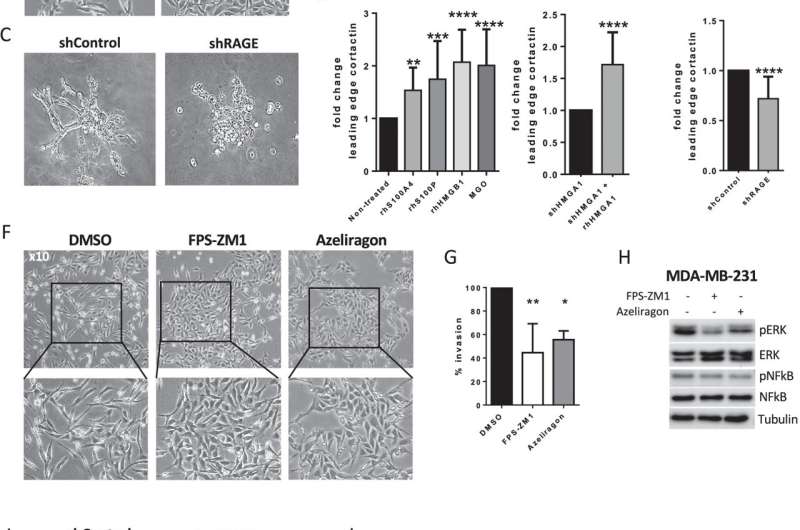This article has been reviewed according to Science X's editorial process and policies. Editors have highlighted the following attributes while ensuring the content's credibility:
fact-checked
peer-reviewed publication
proofread
RAGE as a driver of cell plasticity in aggressive subtype of triple-negative breast cancer

Published online ahead of print in the journal Oncogene, a study led by Josep Villanueva, an Investigator at the Vall d'Hebron Institute of Oncology (VHIO), shows that the receptor for advanced glycation end-product (RAGE) plays a key role in cellular mechanisms of plasticity in mesenchymal triple-negative breast cancer (TNBC) that transform epithelial cells into mesenchymal cells as potent drivers of cancer cell proliferation and tumor invasion.
Results suggest that the therapeutic inhibition of RAGE could open a new treatment avenue for patients with this particularly aggressive TNBC subtype.
Breast cancer is the most frequent cancer among women, affecting 2 million women worldwide each year. TNBC represents about 15% of all breast cancer cases and is a particularly aggressive form of disease with a higher frequency of distant metastases than any other breast cancer subtype, with limited therapeutic options.
Triple-negative breast tumors can acquire a mesenchymal phenotype where cancer cells undergo differentiation and acquire invasive characteristics that promote disease aggressiveness and cancer cell spread.
"The regulation of cellular plasticity represents an important area of research toward more effectively tackling these tumor cells and reduce their capacity to proliferate and spread in such an aggressive manner," says Josep Villanueva, corresponding author of this present study.
The role of RAGE in TNBC tumor cell plasticity
RAGE is a cell surface receptor that fuses with different types of molecules recognized by cells as foreign and has been reported to play a role in the innate immune response linked to inflammation. It is either absent or found expressed at low levels in most healthy cells. The overexpression or activation of RAGE has however been linked to different chronic inflammatory diseases including diabetes, Alzheimer's, fibrosis, and different types of cancer.
Results of previous research led by Josep Villanueva showed an alternative extracellular function of the nuclear protein HMGA1. The investigators evidenced that HMGA1 mediates the transformation of TNBC cells into a mesenchymal state by binding to the RAGE receptor expressed on the cell surface.
"By studying the cellular mechanisms of plasticity, we have now shown that RAGE signaling plays a key role in maintaining the mesenchymal state of aggressive triple-negative breast cancer cells by enforcing the expression of the SNAIL1 protein, which is associated with tumor cell plasticity and a key driver of various types of cancer," explains Mireia Pujals, a Postdoctoral Research Fellow at VHIO and first author of this present study.
The therapeutic promise of targeting RAGE
The researchers then inhibited RAGE with a pharmacological antagonist and at the same time blocked its expression in different TNBC mesenchymal cell lines.
"We observed cell plasticity in which tumor cells lost their mesenchymal characteristics, joined together in colonies and were no longer as invasive. At the molecular level, these cells recovered an epithelial state and RAGE blockade reduced SNAIL expression levels," adds Pujals.
The researchers used xenograft mouse models to establish if this change in cell plasticity by RAGE blockade also occurred in vivo, and observed no difference in primary tumor growth in mice that received treatment versus those that did not.
"Mice treated with a RAGE antagonist did however survive for longer, presented fewer metastases and decreased levels of SNAIL expression. Furthermore, by losing the mesenchymal phenotype, RAGE changes its location in the cell membrane and moves close to the nucleus where it can be implicated in mechanisms of DNA repair damage," observes Carla Mayans, a Ph.D. Student at VHIO and co-author of this study.
Next, they assessed if these processes could also be seen in mesenchymal TNBC samples from patients who presented metastases and those who did not. They reported that the results correlated with those observed in preclinical models. In those patients with metastases, RAGE was found located in the cell membrane, coinciding with the mesenchymal characteristics, while in those who had not developed metastasis, RAGE was situated close to the cell nucleus.
"In all models, we have shown that RAGE plays a key role in the acquisition of mesenchymal characteristics mediated by overexpression of SNAIL, and that targeting RAGE signaling and tumor cell plasticity could help to develop novel, more effective therapeutic strategies against this subtype of metastatic triple-negative breast cancer," concludes Josep Villanueva.
More information: Mireia Pujals et al, RAGE/SNAIL1 signaling drives epithelial-mesenchymal plasticity in metastatic triple-negative breast cancer, Oncogene (2023). DOI: 10.1038/s41388-023-02778-4



















